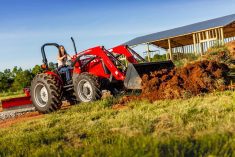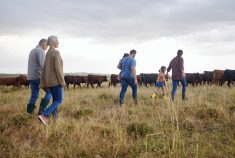A farming couple from Manitoba we’ll call Ron, 67, and Cindy, 65, have run a successful farming operation for the last 40 years. They want to retire; however, none of their three kids have any interest in farming.
The farm is comprised of five quarters of land and some machinery held personally by Ron and Cindy. The land is owned clear of any mortgages or liens. All of the land is cultivated cropland. Its book value is $800,000 and its market value today, they estimate, is $4,800,000.
Although the farming operation has been successful, Ron and Cindy have no off-farm assets aside from their principal residence and their tax-free savings accounts (TFSAs), both of which are fully utilized. They are both healthy and active and want to stay on the homestead as long as they can.
Read Also

Gentle treatments for pain in the neck
Heading toward year-end, people unknowingly tense up against the cold and busyness, causing neck pain that can often be treated with appropriate support and gentle mobility, athletic therapist Kathlyn Hossack says.
Ron and Cindy know if they were to stop farming today, they would not have enough personal assets to maintain their current lifestyle spending of $6,000 per month.
Ron and Cindy approached Nathan Heppner, a certified financial planner, and Erik Forbes, a registered financial planner, both with Forbes Wealth Management in Carberry, Man., to devise a plan on how to maintain their current lifestyle and exit the farming operation.
Personally held land
Their main task, Forbes clarifies, is to develop a plan that will support their desired lifestyle needs of $6,000 per month. Within that task there are issues. What do they do with personally held land? What do they do with corporate assets and their corporation? Moreover, how can they provide a legacy for their children?
When it comes to the personally held land there are several options including the following:
1. Ron and Cindy could sell the land to a third party. Their children are not interested in farming, thus they are not interested in purchasing the land.
2. They could keep the land and rent it out.
3. They could keep the land and devise a crop sharing agreement with someone who would be an active farmer.
If Ron and Cindy sell the land to a third party, it should provide assets to sustain their lifestyle. Selling to a third party will ensure they can utilize the lifetime capital gains exemption and apply the alternative minimum tax (AMT) in the year of sale. Therefore, they should view AMT as a prepayment of future tax, as they will be able to recoup this in future years by applying it against taxable income.
The following is a potential calculation.
Book value ($1,000 per acre) $800,000
Market value ($6,000 per acre) $4,800,000
Capital gain $4,000,000
Lifetime capital gains exemption $2,000,000
Net capital gain $2,000,000
Capital gains inclusion 50 per cent
Taxable capital gain $1,000,000
Personal tax rate 51 per cent
Tax payable $510,000
After the sale and taxes are paid, Ron and Cindy will be left with $4,290,000. The couple could further reduce the tax bill by contributing to their RRSP with any unused contribution room.
Combining the $4,290,000 with their fully utilized TFSAs (each with a market value of $100,000), will give the couple investable assets of $4,490,000. Assuming a modest return of three per cent net of fees and inflation, investable assets of this level would support a monthly income of more than $17,150 gross until the younger spouse reaches the age of 100, Heppner estimates.
Emotional ties
However, the land has been in the family a long time, and there are some emotional ties. Ron and Cindy aren’t opposed to selling the land but have expressed a hesitation to give away their family’s legacy.
If Ron and Cindy don’t want to sell the land, an alternative would be to keep the land and rent it out. Some of the benefits to this strategy are the land stays in the family. The land can be passed down to the next generation. It gives the next generation the opportunity to give farming a try, if they so wish.
There are potential downfalls.
Depending on the rental rate, the income generated by the land may not be sufficient to meet the couple’s lifestyle needs.
Ron and Cindy may also lose access to the lifetime capital gains exemption (LCGE). Loss of the LCGE could happen for several reasons. There is a risk the government abolishes that provision from the Income Tax Act before Ron and Cindy can utilize it.
Another risk is if the land is rented out for an extended period before the parents can utilize their two lifetime capital gains exemptions, Ron and Cindy may no longer qualify for the LCGE because they are not “actively farming” as tax law specifies.
The rule of thumb is you can rent it out for as long as you farmed it and still qualify for the exemption, Forbes explains. This means if they farmed for 20 years, they could rent it out for 20 years or less and still qualify. However, the Canada Revenue Agency (CRA) could easily change their presently tolerant rule and time horizon. Sooner is less risky given the possibility of tax law change.
The couple could also devise a crop sharing arrangement to allow them to maintain ownership of the land. The land will still provide some cash flow to sustain their lifestyle. CRA generally looks more favourably on crop sharing arrangements than on rental agreements when considering qualifying for the lifetime capital gains exemption.
Using a crop share arrangement would mean that Ron and Cindy are less likely to lose access to the lifetime capital gains exemption based on the active farming criteria.
Furthermore, they could lose access to the LCGE in the future if the government abolishes that provision before Ron and Cindy are able to utilize it.
Going the crop share route potentially exposes Ron and Cindy to additional risk. Although there is the potential to earn more with crop sharing versus renting, there is also the potential to earn less because income is based on how well the crops do.
In the end, Ron and Cindy have a tough decision to make. The best option to support their lifestyle needs would be to sell at least a portion of the land. This would also ensure they are able to utilize the lifetime capital gains exemption.















